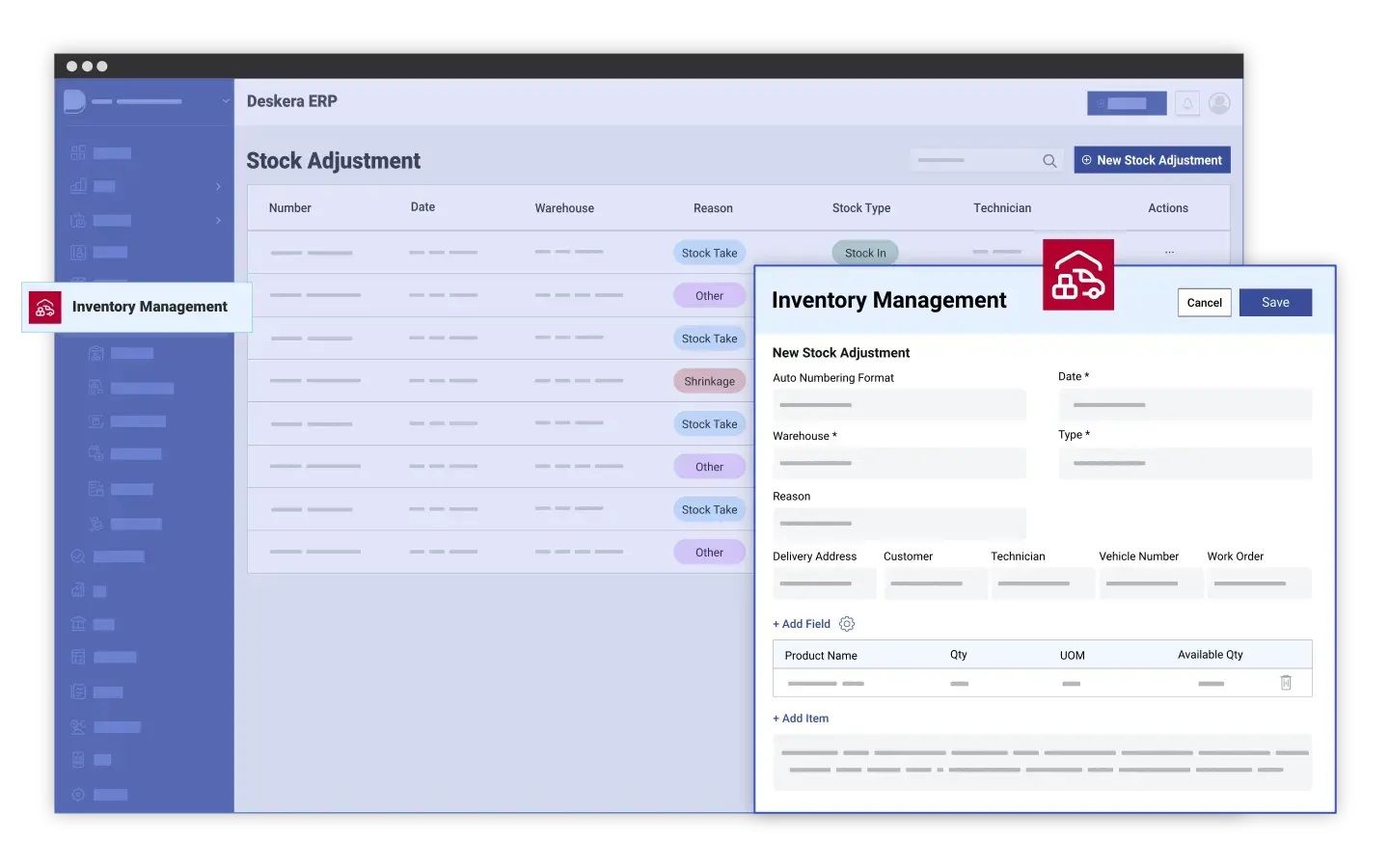In today's fast-paced business environment, efficient inventory management is critical for maintaining a competitive edge. By addressing the challenges of overstocking and understocking, businesses can achieve a notable 10% reduction in inventory costs.
Furthermore, optimizing inventory management to maintain a balance between supply and demand is a key focus for 36% of supply chain professionals involved in analytics initiatives.
Effective inventory tracking software not only enhances operational efficiency but also plays a crucial role in improving customer satisfaction by ensuring timely product availability.
Deskera ERP stands out as a comprehensive solution for businesses seeking to streamline their inventory management processes. This robust platform integrates inventory tracking with other essential business functions such as accounting, sales, and purchasing, providing a unified view of operations.
Deskera ERP's real-time analytics and reporting capabilities empower businesses to make data-driven decisions, ultimately leading to increased productivity and cost savings.
Additionally, its user-friendly interface and customizable features make it an ideal choice for businesses of all sizes looking to optimize their inventory management practices.
What is Inventory Tracking Software?
Inventory tracking software is a powerful tool that enables businesses to effectively manage and monitor their inventory levels, orders, sales, and deliveries. This software is essential for maintaining optimal inventory levels, reducing costs, and improving overall operational efficiency.
Here are some key features and insights into how inventory tracking software transforms business operations:
- Real-Time Inventory Monitoring: With real-time tracking, businesses can instantly view inventory levels, locations, and movements. This immediacy allows for quick decision-making and response to changes in demand, minimizing the risk of stockouts or excess inventory.
- Automated Order Management: The software automates the creation and management of purchase and sales orders, streamlining the procurement and fulfillment processes. This automation reduces manual workload, minimizes errors, and ensures timely restocking and order fulfillment.
- Enhanced Accuracy with Barcode Scanning: By using barcode technology, inventory tracking software ensures precise tracking of inventory items at every stage of the supply chain. This accuracy reduces discrepancies and enhances the efficiency of inventory audits.
- Predictive Inventory Forecasting: Advanced analytics within the software analyze historical data and market trends to forecast future inventory needs. This predictive capability helps businesses anticipate demand fluctuations, plan for seasonal variations, and make informed purchasing decisions, ultimately reducing holding costs.
- Comprehensive Reporting and Analytics: The software provides detailed reports and analytics on various aspects of inventory performance, such as turnover rates, aging inventory, and cost of goods sold (COGS). These insights enable businesses to identify inefficiencies, optimize stock levels, and improve profitability.
- Seamless System Integration: Inventory tracking software integrates with other business systems, such as accounting software, ERP (Enterprise Resource Planning) systems, and e-commerce platforms. This integration ensures a unified operational workflow, enhancing data consistency and operational coordination across departments.
- Supplier and Vendor Management: The software maintains detailed information about suppliers and vendors, including lead times, pricing, and delivery schedules. This feature streamlines procurement processes, improves supplier relationships, and ensures that businesses can source materials efficiently and cost-effectively.
By implementing inventory tracking software, businesses gain a strategic advantage through better control over their inventory.
The software's ability to provide real-time data, automate processes, and deliver actionable insights allows businesses to optimize inventory levels, reduce costs, and enhance customer satisfaction.
In today's competitive market, leveraging such technology is crucial for achieving operational excellence and sustaining business growth.
Advantages and Disadvantages of Inventory Management
The importance of inventory management lies in its ability to balance supply and demand, reduce costs, and improve customer satisfaction. It ensures that the right products are available at the right time, preventing both excess inventory and stockouts.
The objectives of inventory management include:
- Optimizing Inventory Levels: Maintaining the right amount of stock to meet customer demand without overstocking.
- Minimizing Costs: Reducing carrying costs, order costs, and stockout costs.
- Enhancing Customer Service: Ensuring timely availability of products to meet customer expectations.
- Improving Cash Flow: Efficient inventory management frees up capital, improving the business's cash flow.
Advantages of Inventory Management
- Improved Accuracy with Inventory Tracking System: Utilizing an inventory tracking system, businesses can achieve higher accuracy in inventory records. This system minimizes human errors and ensures that inventory data is reliable and up-to-date.
- Efficiency through Real-Time Inventory Tracking System: A real-time inventory tracking system enables businesses to monitor stock levels continuously, allowing for immediate adjustments and reducing the risk of stockouts or overstocking. This efficiency leads to better resource allocation and faster response times.
- Cost Reduction: Effective inventory management helps in reducing carrying costs, minimizing waste, and preventing excess inventory. By optimizing stock levels, businesses can free up capital and reduce storage expenses.
- Enhanced Customer Satisfaction: By maintaining optimal inventory levels and ensuring timely availability of products, businesses can improve order fulfillment rates and customer satisfaction. This reliability builds customer loyalty and enhances brand reputation.
- Scalability for Small Businesses: Inventory tracking software for small businesses is designed to grow with the company. These systems are often scalable, allowing small businesses to expand their inventory management capabilities as they grow.
- Data-Driven Decisions with Best Inventory Tracking Software: The best inventory tracking software provides comprehensive analytics and reporting tools. These insights enable businesses to make informed decisions, forecast demand accurately, and plan for future growth.
Disadvantages of Inventory Management
- High Initial Setup Costs: Implementing an inventory tracking system can be costly initially. The investment in hardware, software, and training can be significant, particularly for small businesses.
- Complexity of Integration: Integrating an inventory tracking system with existing business processes and systems can be complex and time-consuming. Ensuring seamless integration with other business functions is critical to avoid disruptions.
- Maintenance and Updates: Continuous maintenance and regular updates are necessary to keep the inventory tracking software running smoothly. This ongoing requirement can add to the operational costs and necessitate dedicated IT support.
- Potential for Technical Issues: Relying heavily on technology can expose businesses to risks of technical issues, such as system failures, data breaches, or software glitches. These issues can disrupt operations and require swift resolution to minimize impact.
- Learning Curve for Staff: Implementing a new inventory management system requires training staff to use the software effectively. The learning curve can be steep, and staff may initially resist changes to their workflow.
17 Benefits of Inventory Tracking Software
Implementing an inventory tracking system is crucial for businesses aiming to streamline their inventory management processes. By leveraging the best inventory tracking software, companies can achieve greater efficiency, cost savings, and customer satisfaction.
Here are some key benefits of using an inventory tracking system:
1. Enhanced Accuracy and Reduced Errors
An inventory tracking system significantly improves accuracy by automating the tracking process. Manual tracking is prone to errors, which can lead to discrepancies in stock levels and order fulfillment.
With real-time inventory tracking software, businesses can ensure that their inventory data is always accurate and up-to-date, minimizing the risk of costly mistakes.
Moreover, automated inventory tracking reduces the time and effort required for regular audits and reconciliations. This not only enhances operational efficiency but also frees up valuable resources that can be redirected towards strategic initiatives.
By providing detailed and precise inventory records, the software helps businesses maintain compliance with industry regulations and standards, further safeguarding against potential financial penalties and reputational damage.
2. Real-Time Visibility
One of the standout features of a real-time inventory tracking system is the ability to monitor stock levels and movements continuously. This real-time visibility allows businesses to make informed decisions quickly, respond to changes in demand, and optimize their inventory levels.
For small businesses, this capability is particularly valuable as it helps them stay competitive without overextending resources.
Additionally, real-time visibility facilitates better coordination across different departments, such as sales, procurement, and warehousing. When all departments have access to up-to-date inventory data, it enhances collaboration and ensures that everyone is on the same page.
This seamless flow of information helps prevent bottlenecks and ensures that customer orders are fulfilled promptly. Moreover, real-time data can provide valuable insights into inventory trends, helping businesses anticipate future needs and plan their purchasing strategies more effectively.
3. Cost Reduction
Effective inventory management through inventory tracking software can lead to significant cost savings. By optimizing stock levels, businesses can reduce carrying costs, minimize waste, and avoid the expenses associated with overstocking or stockouts.
Inventory tracking software for small businesses is designed to maximize efficiency, allowing them to allocate resources more effectively and improve their bottom line.
Furthermore, inventory tracking software can help businesses negotiate better terms with suppliers by providing detailed insights into purchasing patterns and inventory turnover rates. With accurate data on hand, companies can order in bulk when advantageous or adjust order quantities to take advantage of discounts and promotions.
Additionally, the software can assist in identifying slow-moving items, enabling businesses to implement strategies such as promotions or discounts to clear out excess stock, thereby freeing up capital that can be used more productively elsewhere.
4. Improved Customer Satisfaction
Maintaining optimal inventory levels ensures that products are available when customers need them. By using the best inventory tracking software, businesses can fulfill orders promptly and accurately, leading to higher customer satisfaction and customer loyalty. Timely and reliable order fulfillment is essential for building a strong brand reputation and encouraging repeat business.
In addition, real-time inventory tracking software allows businesses to provide better customer service by offering accurate information about product availability.
When customers inquire about a product, sales representatives can quickly check current stock levels and provide precise delivery estimates. This transparency builds trust and enhances the customer experience.
Moreover, efficient inventory management reduces the likelihood of backorders and delays, ensuring that customers receive their products when expected. Happy customers are more likely to recommend the business to others, further driving growth and success.
5. Data-Driven Insights
Inventory tracking software provides valuable analytics and reporting tools that help businesses understand their inventory patterns and trends. These insights enable companies to forecast demand more accurately, plan for seasonal variations, and make strategic decisions. For small businesses, having access to such data can be a game-changer, providing a competitive edge in the market.
Additionally, data-driven insights can help identify inefficiencies and areas for improvement within the supply chain. By analyzing key metrics such as turnover rates, lead times, and supplier performance, businesses can uncover opportunities to streamline operations and reduce costs.
Predictive analytics can also be leveraged to anticipate future demand shifts, allowing companies to proactively adjust their inventory strategies. This level of informed decision-making not only enhances operational efficiency but also helps in maintaining a balance between inventory investment and service levels, ultimately contributing to sustained business growth.
6. Scalability and Flexibility
Inventory tracking software for small businesses is typically scalable, meaning it can grow with the company. As the business expands, the software can accommodate increasing inventory volumes and more complex inventory management needs. This scalability ensures that the investment in the software continues to provide value as the business evolves.
Moreover, the flexibility of inventory tracking software allows businesses to adapt to changing market conditions and customer demands.
Whether a company is adding new product lines, entering new markets, or adjusting to seasonal fluctuations, the software can easily be configured to support these changes.
This adaptability not only helps businesses stay agile and responsive but also minimizes disruption during periods of growth or transition.
Additionally, scalable software often comes with modular features, enabling businesses to add new functionalities as needed without overhauling their entire system, thereby ensuring a cost-effective and future-proof solution.
7. Streamlined Operations
By integrating with other business systems such as accounting, sales, and purchasing, an inventory tracking system creates a cohesive operational workflow. This integration simplifies processes, reduces duplication of efforts, and enhances overall operational efficiency.
Real-time inventory tracking software ensures that all departments have access to the same accurate inventory data, promoting better coordination and collaboration.
Furthermore, streamlined operations foster transparency across the organization, allowing for better strategic decision-making and resource allocation. When departments share real-time inventory information, they can coordinate sales forecasts with procurement schedules, align production with demand fluctuations, and optimize inventory turnover ratios.
This alignment not only improves efficiency but also reduces lead times and enhances customer satisfaction. Additionally, by eliminating silos and promoting cross-functional communication, businesses can identify and address operational bottlenecks more effectively, ultimately improving overall performance and profitability.
8. Enhanced Security and Loss Prevention
Inventory tracking software enhances security by providing better oversight and control over inventory. With features such as audit trails and user permissions, businesses can reduce the risk of theft, fraud, and other security issues. By keeping a precise record of inventory movements, the software helps prevent loss and ensures accountability.
Moreover, advanced security measures within inventory tracking software protect sensitive inventory data from unauthorized access or manipulation.
Encryption protocols and secure authentication methods safeguard information stored within the system, ensuring compliance with data protection regulations and industry standards.
These security features not only mitigate risks associated with internal and external threats but also instill confidence among customers and stakeholders.
Additionally, by maintaining a transparent and secure inventory management system, businesses can build trust with suppliers and partners, fostering stronger relationships and promoting collaborative growth opportunities.
9. Optimized Warehouse Management
Effective inventory tracking software improves warehouse management by organizing inventory in a way that maximizes space and efficiency. Features such as barcode scanning and real-time location tracking enable businesses to streamline picking, packing, and shipping processes. This optimization leads to faster order fulfillment and reduced labor costs.
Furthermore, optimized warehouse management extends beyond operational efficiencies to include better asset utilization and inventory visibility. By accurately tracking inventory movements and storage locations in real time, businesses can minimize stockouts and excess inventory, improving overall inventory turnover rates.
Additionally, insights gained from warehouse analytics help businesses identify areas for improvement, such as layout optimization or workflow adjustments, to further enhance efficiency.
This proactive approach not only enhances productivity but also ensures that warehouses operate at peak performance levels, supporting business growth and customer satisfaction initiatives.
10. Improved Supplier and Vendor Relationships
An inventory tracking system helps businesses maintain accurate records of supplier and vendor performance, including delivery times, order accuracy, and pricing.
This information allows companies to build stronger relationships with their suppliers by holding them accountable and negotiating better terms. Improved supplier management leads to more reliable inventory replenishment and better overall supply chain performance.
Moreover, effective supplier relationship management facilitated by inventory tracking software goes beyond transactional interactions to foster collaborative partnerships.
By sharing real-time inventory data with suppliers, businesses can optimize order fulfillment processes, anticipate demand fluctuations, and mitigate supply chain risks.
Collaborative forecasting and planning initiatives enable suppliers to align production schedules with customer demand, reducing lead times and ensuring timely product availability.
Enhanced transparency and communication in supplier relationships not only improve operational efficiency but also drive mutual growth and innovation, positioning businesses for long-term success in competitive markets.
11. Enable Accurate Reordering
With inventory tracking software, businesses can automate the reordering process based on preset thresholds. This ensures that stock levels are maintained at optimal levels, preventing stockouts and overstocking.
Accurate reordering helps in maintaining a smooth supply chain and ensures that inventory is available when needed.
Furthermore, automated reordering capabilities supported by inventory tracking software enhance forecasting accuracy and inventory control.
By analyzing historical data and demand patterns, businesses can establish replenishment triggers that align with fluctuating customer demand and seasonal variations.
This proactive approach not only minimizes the risk of understocking during peak periods but also reduces excess inventory carrying costs during slower periods.
Additionally, automated reordering fosters efficiency in procurement processes by streamlining supplier communications and order processing, allowing businesses to focus on strategic initiatives and customer-centric activities.
By optimizing inventory management practices, businesses can achieve operational excellence and sustain competitive advantages in dynamic market environments.
12. Prevent Stock Overselling
Inventory tracking systems help prevent the problem of overselling by synchronizing inventory levels across all sales channels in real time. This prevents situations where customers order items that are no longer in stock, thereby improving customer satisfaction and reducing the risk of lost sales.
Moreover, real-time inventory synchronization supported by inventory tracking software enables businesses to offer accurate product availability information to customers across various sales channels.
By maintaining up-to-date inventory data, businesses can effectively manage customer expectations and fulfill orders promptly, enhancing overall service reliability and brand reputation.
Additionally, preventing stock overselling minimizes order cancellations and backorders, which can negatively impact customer loyalty and customer retention.
By leveraging inventory tracking software to maintain inventory accuracy and visibility, businesses can optimize sales performance and maximize revenue opportunities while delivering exceptional customer experiences.
13. Diversify Sales Channels
Inventory tracking software facilitates the addition of new selling channels by integrating seamlessly with various e-commerce platforms, marketplaces, and POS systems.
This integration allows businesses to expand their reach and tap into new markets without the hassle of managing inventory separately for each channel.
Furthermore, diversifying sales channels through inventory tracking software enhances market agility and business resilience.
By leveraging centralized inventory data and automated order management processes, businesses can seamlessly synchronize product listings, pricing strategies, and promotional campaigns across multiple channels.
This unified approach not only simplifies inventory management but also enables businesses to capitalize on omnichannel retailing trends and consumer preferences.
Additionally, by diversifying sales channels, businesses can reduce dependency on any single sales platform or market segment, mitigating risks associated with market fluctuations or competitive pressures.
Ultimately, adopting a multi-channel sales strategy supported by inventory tracking software empowers businesses to reach broader audiences, drive sales growth, and foster sustainable business expansion.
14. Automate Inventory Management
Automation is a key benefit of inventory tracking software. Tasks such as updating stock levels, generating reports, and reordering can be automated, reducing the need for manual intervention. This automation saves time, reduces errors, and allows staff to focus on more strategic tasks.
In addition to streamlining routine tasks, automation can enhance overall operational efficiency by integrating with other business systems such as accounting, sales, and procurement.
This seamless integration ensures that data flows smoothly across different departments, reducing the likelihood of discrepancies and improving decision-making processes.
Moreover, automated inventory management can provide real-time alerts and notifications, enabling businesses to respond quickly to low stock levels, expired items, or other critical issues. This proactive approach helps maintain optimal inventory levels, improve service quality, and ultimately drive business growth.
15. Predicting Inventory Needs for Seasonal Purchases
Inventory tracking software provides tools for forecasting demand based on historical data and trends. This is particularly useful for seasonal businesses, as it allows them to anticipate and prepare for peak periods by ensuring adequate stock levels.
Furthermore, these forecasting tools can help businesses identify patterns and anomalies in their inventory data, enabling them to adjust their strategies proactively.
By understanding the timing and scale of seasonal demand fluctuations, companies can optimize their purchasing schedules, negotiate better terms with suppliers, and avoid the pitfalls of overstocking or stockouts.
Additionally, accurate seasonal forecasting supports marketing and promotional planning, allowing businesses to align their sales efforts with expected inventory availability, thereby maximizing revenue opportunities during peak seasons.
16. Efficient Management of Multiple Warehouses
For businesses operating multiple warehouses, inventory tracking software provides centralized control over all inventory locations. This centralization ensures that stock levels are balanced across warehouses, reducing the risk of stockouts in one location while another has excess inventory.
Additionally, efficient management of multiple warehouses allows for optimized routing and logistics. With centralized data, businesses can make more informed decisions about where to store products based on demand patterns, minimizing shipping times and costs.
Inventory tracking software can also facilitate better coordination between warehouses, enabling seamless transfers and reducing the time and expense associated with inter-warehouse shipments.
This level of integration and control enhances overall supply chain efficiency, ensuring that inventory is always positioned in the right place at the right time to meet customer demand.
17. Enhanced Productivity and Operational Efficiency
By streamlining and automating inventory management processes, inventory tracking software significantly boosts productivity. Employees spend less time on manual inventory tasks and more time on value-added activities. The efficiency gained from using inventory tracking software translates into higher overall productivity and better resource utilization.
Additionally, automated inventory systems reduce the likelihood of human error, which can be time-consuming and costly to correct. This ensures that employees can focus on more strategic tasks, such as improving customer relationships and developing new business opportunities.
The streamlined processes facilitated by inventory tracking software also lead to faster turnaround times and improved order accuracy, further enhancing overall operational efficiency. As a result, businesses can scale their operations more effectively and meet increasing demand without a proportional increase in labor costs.
How Deskera ERP Can Enhance Inventory Tracking?
Deskera ERP provides a comprehensive suite of tools designed to optimize inventory management processes.

Here's how Deskera ERP can help with inventory tracking:
1. Real-Time Inventory Tracking
Deskera ERP offers real-time visibility into inventory levels across multiple locations. This feature ensures that businesses always have up-to-date information on stock availability, reducing the risk of stockouts and overstocking.
2. Automated Reordering
The software allows for automated reordering based on preset inventory thresholds. This automation helps maintain optimal stock levels, ensuring that businesses can meet customer demand without holding excess inventory.
3. Centralized Control
Deskera ERP integrates inventory data from various warehouses and sales channels into a centralized system. This centralization streamlines inventory management, making it easier to balance stock levels and coordinate across different locations and platforms.
4. Advanced Analytics and Reporting
The ERP system provides detailed analytics and reporting tools that offer insights into inventory trends, turnover rates, and demand patterns. These insights enable businesses to make data-driven decisions, improve forecasting accuracy, and optimize purchasing strategies.
5. Barcode Integration
Deskera ERP supports barcode technology, which simplifies the tracking of inventory movements and enhances accuracy. This integration helps in quick and accurate inventory audits, reducing manual errors and improving operational efficiency.
6. Seamless Integration with Sales Channels
The software integrates seamlessly with various e-commerce platforms, marketplaces, and POS systems, facilitating multi-channel sales. This integration ensures that inventory levels are synchronized across all sales channels, preventing overselling and improving customer satisfaction.
7. Improved Supplier Management
Deskera ERP allows businesses to track supplier performance and manage vendor relationships effectively. With accurate records of delivery times, order accuracy, and pricing, businesses can negotiate better terms and ensure reliable inventory replenishment.
8. Scalability and Flexibility
As businesses grow, Deskera ERP scales with them, accommodating increasing inventory volumes and more complex inventory management needs. This scalability ensures that the investment in the ERP system continues to provide value as the business evolves.
9. Enhanced Security
Deskera ERP provides robust security features, including user permissions and audit trails, to protect sensitive inventory data. These features help reduce the risk of theft, fraud, and other security issues, ensuring accountability and transparency in inventory management.
10. Mobile Access
Deskera ERP offers mobile access, allowing business owners and managers to monitor and manage inventory from anywhere. This flexibility ensures that critical inventory decisions can be made on the go, further enhancing responsiveness and efficiency.
By leveraging Deskera ERP for inventory tracking, businesses can achieve greater accuracy, efficiency, and control over their inventory management processes, ultimately driving growth and improving their bottom line.
Key Takeaways
Implementing inventory tracking software offers a multitude of benefits that can transform how businesses manage their inventory.
Some of the benefits of implementing inventory tracking software are:
- Enhanced Accuracy and Reduced Errors: Automating inventory tracking processes significantly improves accuracy, minimizes errors, and ensures up-to-date inventory data, reducing the risk of costly discrepancies.
- Real-Time Visibility: Continuous monitoring of stock levels allows for informed decision-making, quick response to demand changes, and optimized inventory management, which is crucial for small businesses.
- Cost Reduction: Effective inventory management reduces carrying costs, minimizes waste, and prevents overstocking or stockouts, leading to substantial cost savings and better resource allocation.
- Improved Customer Satisfaction: Accurate and timely order fulfillment, enabled by optimal inventory levels and real-time tracking, enhances customer satisfaction and loyalty, boosting brand reputation.
- Data-Driven Insights: Advanced analytics and reporting tools provide valuable insights into inventory patterns, aiding in demand forecasting, seasonal planning, and strategic decision-making.
- Scalability and Flexibility: Inventory tracking software is scalable and adaptable, accommodating business growth and changing market conditions without overhauling the system.
- Streamlined Operations: Integration with other business systems creates a cohesive workflow, reducing duplication, enhancing coordination, and improving overall operational efficiency.
- Enhanced Security and Loss Prevention: Features like audit trails and user permissions enhance security, reduce the risk of theft and fraud, and ensure accountability in inventory management.
- Optimized Warehouse Management: Efficient organization of inventory with features like barcode scanning and real-time location tracking leads to faster order fulfillment and reduced labor costs.
- Improved Supplier and Vendor Relationships: Accurate tracking of supplier performance and better negotiation of terms lead to more reliable inventory replenishment and improved supply chain performance.
- Enable Accurate Reordering: Automated reordering based on preset thresholds ensures optimal stock levels, preventing stockouts and overstocking, and maintaining a smooth supply chain.
- Prevent Stock Overselling: Synchronizing inventory levels across all sales channels in real time prevents overselling, improving customer satisfaction and reducing lost sales.
- Diversify Sales Channels: Seamless integration with various sales platforms allows businesses to expand their reach, manage inventory efficiently across multiple channels, and tap into new markets.
As businesses continue to evolve, adopting a robust inventory tracking system becomes a crucial step towards achieving operational excellence, driving growth, and maintaining a competitive advantage.
Whether you're a small business looking to scale or an established enterprise seeking efficiency, the implementation of inventory tracking software is a game-changing investment for long-term success.
Deskera ERP stands out as a comprehensive solution that enhances inventory tracking capabilities. With its real-time tracking, automated reordering, and seamless integration with other business systems, Deskera ERP helps businesses optimize their inventory management processes, ensuring they remain competitive and efficient in today's dynamic market.
Related Articles











